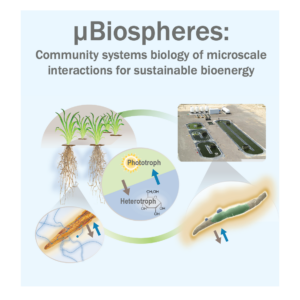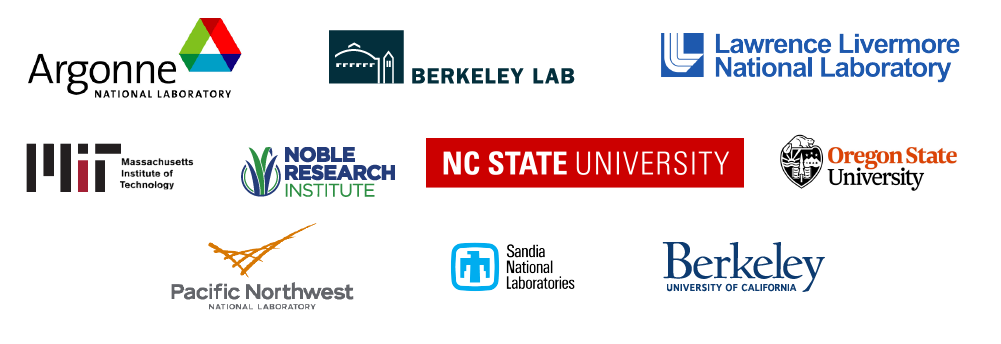µBiospheres SFA
 Tools and functionality to support a systems biology approach to understanding interactions in bioenergy-relevant microbial communities
Tools and functionality to support a systems biology approach to understanding interactions in bioenergy-relevant microbial communities
The µBiospheres Science Focus Area (SFA): Community systems biology of microscale interactions for sustainable bioenergy is led by Dr. Rhona Stuart at Lawrence Livermore National Laboratory (LLNL), and focuses on microbial interactions within algal and plant “microbiospheres” of influence (phycosphere, rhizosphere, endosphere, hyphosphere). The ultimate goal is to discover cross-cutting principles that regulate formation and maintenance of these interactions and their system-level resource allocation consequences, in order to develop a general predictive framework for system-level impacts of microbial partnerships. The approach encompasses single cell analyses, quantitative isotope tracing of elemental exchanges, system-scale ‘omics measurements, and multi-scale modeling including constraint-based genome-scale metabolic modeling to predict and test interactions within microbial communities.
The µBiospheres SFA improved the quality of genome annotations to improve draft metabolic models within KBase, by developing tools for importing, comparing, and merging metabolic annotations. These tools expedite the curation process during model building and produce the high-quality, multi-evidenced curated models needed to investigate the complex interactions within microbial communities.
Longer term, the team seeks to engage with KBase to interpret and integrate data streams to further goals around understanding and predicting ecological, biophysical, and biochemical dynamics of multi-taxa communities, as well as the metabolite fluxes that regulate trophic interactions.
Collaborative Development Projects
Improving Draft Metabolic Models:
Create annotation tools that accept multiple lines of evidence to determine an optimal consensus annotation from data like EC numbers, KEGG, and MetaCyc reaction identifiers.
Functionality and Tools
- Import Annotations From Staging: Provides a way to upload third-party annotations like EC and KEGG into KBase. (Released)
- Bulk Import Annotations From Staging: Provides a way to upload third-party annotations to add to an existing genome into KBase in bulk. (Released)
- Compare Metabolic Annotations: Compare and contrast the metabolic annotations from multiple sources. (Released)
- Merge Metabolic Annotations: Generate a consensus annotation by combining multiple annotation sources. (Released)
Probabilistic Annotation and Ensemble Metabolic Modeling
Given multiple multiple annotation sources: 1) calculate reaction probabilities, 2) propagate reaction probabilities into metabolic modeling, and 3) condense results of probabilistic modeling to actionable insights. (in Development)
Additional Information
Meet the Members
SFA Principal Investigator: Rhona Stuart1
KBase Contact: Chris Henry2,3
Lead Developers: Patrik D’haeseleer1, Jeffrey Kimbrel1
Project Team Leads: Patrik D’haeseleer1, Ali Navid1, Ben Bowen4
Affiliations: 1Lawrence Livermore National Laboratory, 2Argonne National Laboratory, 3KBase, 4Lawrence Berkeley National Laboratory
Resources
- LLNL SFA Project Website – “µBiospheres: Community systems biology of microscale interactions for sustainable bioenergy”
- Functional Annotation Tools (14 April 2021) – KBase tutorial webinar
- KBase Functional Annotation Documentation
